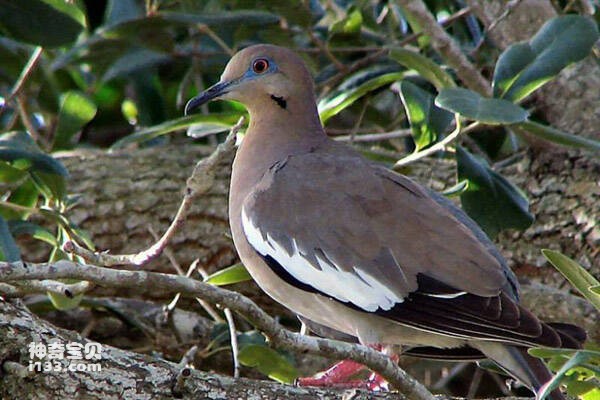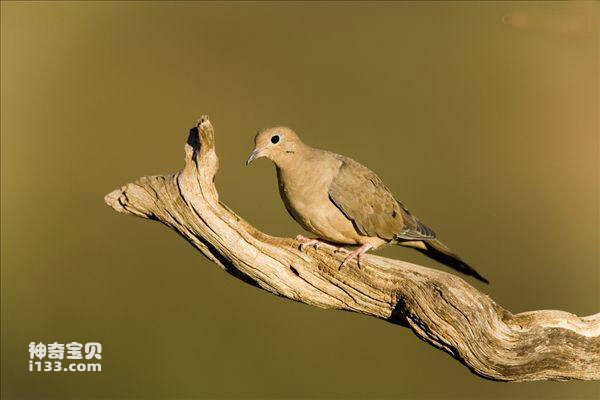Zenaida macroura
IUCN
LCBasic Information
Scientific classification
- name:Zenaida macroura
- Scientific Name:Zenaida macroura,Mourning Dove
- Outline:Landfowl
- Family:
Vital signs
- length:22.5-34cm
- Weight:86-170g
- lifetime:4-5 years
Feature
Pigeons have a special place in folklore and mythology
Distribution and Habitat
Origin: Bahamas, Belize, Bermuda, Canada, Cayman Islands, Colombia, Cuba, Dominican Republic, El Salvador, Guatemala, Haiti, Honduras, Mexico, Nicaragua, Panama, Puerto Rico, Turks and Caicos Islands.
Breeding grounds: Jamaica and the United States.
Traveler: Saint Pierre and Miquelon Islands.
Non-breeding place: Costa Rica.
Wandering: Greenland and England.
Mourning pigeons are highly adapted birds and are found in a wide variety of habitats. It is more common in open woodlands and forest edges near grasslands and fields. It is most abundant in agricultural and suburban areas, where humans have created large areas of suitable habitat. It inhabits dense deciduous or coniferous forests or rocky mountainous and rural areas. Build a nest in a crack in the rock, on a cliff, or on a branch of a tree. Mourning pigeons occupy most suitable environments, including urban areas, farmland, pasture, grassland and woodland areas, but they do not like swamps and dense forests. Mournin
Appearance
The male bird is 23-34 cm long, the female is 22.5-31 cm long, the wingspan is about 45 cm, the male bird weighs 96-170 grams, and the female bird weighs 86-156 grams. The plumage is generally light grayish-brown, with lighter underside wings and a pink head and chest. The wings have black spots and the outer tail feathers are white, contrasting strongly with the black feathers on the inner layer. There is a distinct crescent-shaped area of black feathers below the eye. The eyes are black with thin skin around them. Adult males have bright grape purple patches on both sides of the neck and bright pink on the chest and above. The crest of the adult male is distinctly blue-gray. Female adult birds differ little from males in body size, but generally have more gray plumage than males. Very few males have patches of colored feathers above the shoulders and on the neck. The chicks have darker plumage.
The pigeon has four toes on each foot, three forward and one backward, and its legs are
Details
Mourning Dove (Zenaida macroura) is a mourning dove with five subspecies.

Mourning pigeons that live in the south do not migrate. In the north are all migratory birds. They breed in the north and winter in the south. In particular, mourning pigeons, which live in southern Canada, spend the winter in the southern United States, passing through Mexico and on to Panama or the West Indies in Central America. Animals that breed on the Canadian prairies overwinter. Populations in southern Central America remain there only during the winter and move north during the breeding season. The southern migration usually takes place between September and November, and in the spring between March and May, when they return north to their breeding areas. Migrating birds may fly about 1,600 kilometers to reach their breeding or wintering areas. These powerful fliers are capable of reaching speeds of 88 km/h.
Most of the migratory routes of mourning pigeons are mainly overland. And it would take at least 1,600 kilometers to reach its destination. However, on rare occasions, mourning pigeons also pass through the Gulf of Mexico. In the spring, the northward migration lasts from late March to May; In autumn, the southward migration lasts from late August to November and usually takes place in large groups during the day. Mourning pigeons from Canada migrate the farthest and may overwinter in Mexico or further south. Mourning pigeons that spend the summer in southerly areas stay longer and migrate less often. In the southern part of its range, the mourning dove is a resident bird, settling year-round.

Mourning pigeons often travel and forage together in pairs or small groups. They are famous for their song, which often gives people a feeling of sadness, from which it gets its name. Dove 'calls is characteristic, can use a range of different calls to communicate with other dove, sounds like "goo - sitter - goo - blare -" (" goo "for the stress, after gradually weak. The throats can be heard before the first "goo"), which the male uses to attract a mate; Males looking for a new mate greet females with a soft "oh" sound; When threatened, both male and female birds use a short "noo-noo" sound to alert. As it flies, the flapping of its wings makes an unpleasant whistling sound. The howl is even louder during takeoff and landing.
Mourning pigeons mainly eat plant seeds, both native and exotic plant seeds. The pigeon has a special preference for several plants, mainly pine cones, liquidgum seeds, amaranth seeds, canary grass seeds, corn, sesame and wheat. When their favorite food is in short supply, they feed on the seeds of other plants, including buckwheat, rye, herba, and polygonum. Coarse sand, such as small grit and sand, is often swallowed to aid digestion.
The courtship begins with the noisy flight of the male, followed by a graceful glide, extending its wings and lowering its head in a graceful arc. After landing, the male bird raises his chest high, nods his head, calls loudly and approaches the female. This mating call can often be heard during the warmer months of the year. If a male bird sees a female he likes, he will chase away other males on the same branch; Until the courtship is successful, it will establish its territory. Mourning pigeon pairs often preen each other's feathers with their beaks.
After a successful courtship, the male will show the female the nesting sites, and the female will choose one of the sites to settle down, and the male will fly out to collect the nest material and bring it back to the female. The male will stand on the female's back and give her the nest material, which she will then use to build a nest. Nest wood consists of twigs, needles or blades of grass, and is therefore a very fragile construction. It takes more than 10 hours a day to build the nest, and it takes 3-4 days to weave the nest together. These pigeons sometimes need the abandoned nests of other pigeons, other birds, or tree-dwelling mammals such as squirrels.

Crows, grackles, domestic cats or rat snakes prey on the eggs as the birds build their nests. Cowbirds, on rare occasions, also lay their eggs in the nest of mourning pigeons. In this case, slightly less than a third of cowbird eggs are rejected by mourning pigeons, but the mourning pigeons' vegetarian habits are not suitable for cowbirds. The average lifespan of young mourning pigeons in the wild is about 1-1.5 years, and if the young survive, the average lifespan is usually 4-5 years.

Mourning doves appear frequently in Indian literature, especially those related to spiritualism. In Puebro mythology, the mourning dove can help people find water and is also a raingiver, but the rain does not always come, so the mourning dove will feel sad. The Lenape people of Oklahoma in the United States respect the mourning pigeon as a "devotive prayer" (mamendhakema), and do not kill and eat mourning pigeons as other Indians do, because doing so would be guilty of the Lenape people.
Mourning dove "; Carolina Turtle-Dove" His name appears in Audubon's Atlas of the Birds of America. The image of the mourning dove frequently appears in American literature, and the image of the mourning dove is increasingly found in the poetry of contemporary American and Canadian poets such as Robert Burley, Jared Carter, Lorraine Niedeker, and Charles Wright. For Native Americans, mourning doves represent and communicate with the spirit. They believe that when the mourning dove appears, there will be growth opportunities and messages. Mourning doves are also considered an omen of death, but only if they are seen under extremely unusual circumstances.
Mourning pigeons have a special place in folklore and mythology. Noah released a dove from the ark, and when it returned with an olive branch, it was a sign that the land was near. When eating, mourning pigeons store seeds on crops for later digestion. The most recorded for a single crop is 17,200 bluegrass seeds. When these pigeons fall asleep, they rest their heads between their shoulders, close to their bodies, rather than tucking their heads under their shoulder feathers like many other birds do. These birds are believed to be close relatives of the extinct "passenger" pigeon.
Listed in the International Union for Conservation of Nature Red List of Threatened Species (IUCN) for 2016 ver 3.1 - Not Threatened (LC).
Protect wild animals and eliminate wild meat.
Maintaining ecological balance is everyone's responsibility!








